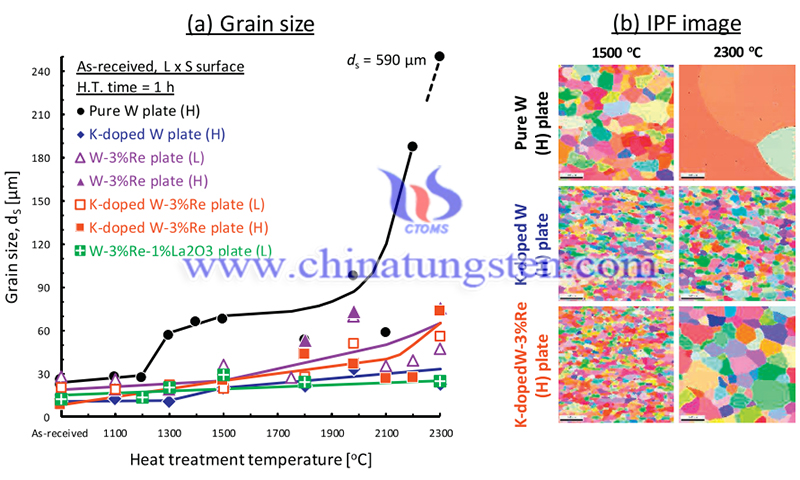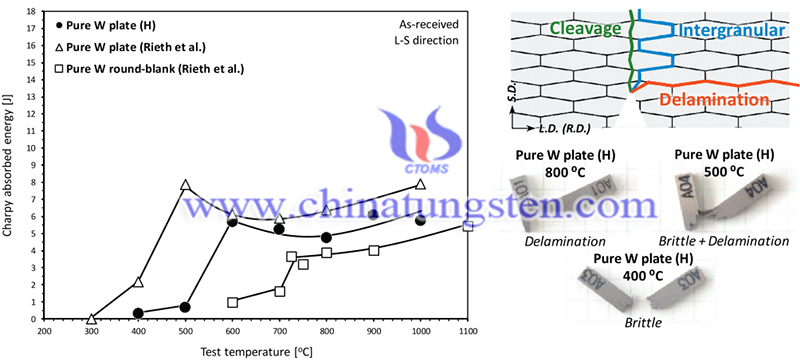Charpy Impact Properties of Modified Tungsten Materials
- Details
- Category: Tungsten's News
- Published on Monday, 29 May 2023 19:18
The ductile transfer temperature (DBTT) of modified tungsten materials can be evaluated by several test methods, such as tensile testing, bending testing, Charpy impact testing and fracture toughness testing. The DBTT is highly dependent on the test method, strain rate and specimen shape. Researchers have used Charpy impact and tensile tests to evaluate DBTT.
Charpy impact tests were performed according to EU standards using KLST Charpy V-notch specimens along the L-S (for plates) and L-R (for bars) directions in a vacuum at temperatures ranging from 200 to 1000°C (first letter (L): direction perpendicular to the expected crack plane, second letter (S and R): direction of expected crack growth.

Even though the main chemical composition of the modified tungsten materials is the same, the DBTT and the upper rack energy (USE) vary with the materials, which have undergone different manufacturing methods and histories (e.g., deformation rates).
Most materials show a mixture of brittle fracture and brittle and delamination fracture below DBTT, and delamination fracture above DBTT. In contrast, W bars doped with K showed ductile deformation with little or no cracking above 800°C. The relationship between DBTT and grain size (dS) and USE and grain size (dS) was of Hall-Petch type. Those different DBTT and USE, therefore, cannot be determined by the main chemical composition only, but may be due to the individual special grain structure depending on the manufacturing method and history.
The DBTT is 550°C for pure W(H) plates; 350°C for K-doped W(H) plates; 450°C for W-3% Re(H) plates; 550°C for W-3% Re(L) plates; 250°C for K-doped W-3% Re(H) plates; and 550°C for W-3% Re-1% La2O3(L) plates. For highly deformed materials ("H"), K-doping and Re-addition lead to a decrease in DBTT of about 200 and 100 °C and an increase in USE of about 40 and 30%, respectively.
In contrast, W-3%Re(L) and W-3%Re-1%La2O3(L) plates show very low absorbed energies compared to the highly deformed materials. No significant positive effect of La2O3 particle dispersion was observed in the low-deformation materials. The appearance of the tested specimens showed rapid extension of delamination in the low-deformation materials with almost no plastic deformation of the base metal, while the high-deformation materials showed delamination accompanied by sufficient bending (plastic deformation). These results suggest that Charpy impact properties can be improved by K-doping and Re-addition when sufficient deformation is applied during rolling and forging.

In addition, a synergistic effect of K-doping and Re-addition is clearly observed. In contrast, the dispersion effect of La2O3 particles needs to be clarified by application to highly deformed materials in future work.
Reference: Nogami S, Hasegawa A, Fukuda M, et al. Mechanical properties of tungsten: recent research on modified tungsten materials in Japan[J]. Journal of Nuclear Materials, 2021, 543: 152506.
- Tungsten Manufacturer & Supplier, Chinatungsten Online: www.chinatungsten.com
- Tungsten News & Prices of China Tungsten Industry Association: www.ctia.com.cn
- Molybdenum News & Price: news.molybdenum.com.cn
- Tel.: 86 592 5129696; Fax: 86 592 5129797; Email: sales@chinatungsten.com



 sales@chinatungsten.com
sales@chinatungsten.com